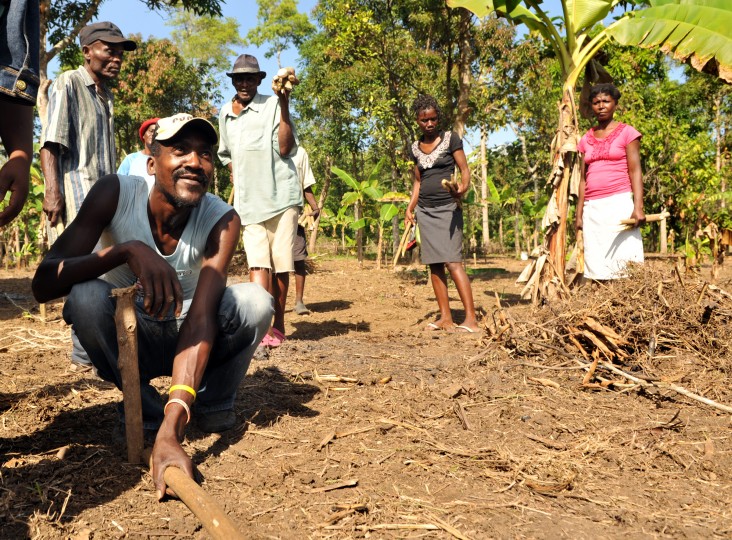
May 2014—In northern Haiti's Acul du Nord, one of the communes receiving assistance under a USAID agriculture program, a path through a lush forest leads to an opening where 25 farmers—women and men—sing energetically as they worked together to create a new cocoa plantation.
While the farmers sing motivating songs, they mark the ground with wooden sticks to identify locations for the trees, preparing the ground for cocoa seedlings. They are going to plant trees of the Criollo variety, which produces cocoa to make some of the most exclusive chocolates in the world.
“A seedling takes about three years to become a mature tree that produces pods ready to be picked,” said Dominique Jean Raoul, a cocoa specialist working on the USAID project. “These trees will produce high-quality cocoa, which can be exported to other countries, bringing back needed income.”
This is good news for farmers in Haiti, where half the population lives on less than $1.25 per day. And while approximately 60 percent of Haitians work in agriculture, up to half of Haiti’s food is imported. Although quality cocoa can sell for a high price, previously, Haitian cocoa rarely met international standards and failed to attract the high-end export market.
“In the past, we planted cocoa but did not use good farming methods,” said one of the women farmers in Acul du Nord. “This program is teaching us important techniques, such as how to prepare the land and take care of the trees, and how to treat the beans to get the best flavor. Now we can get higher yield and produce better quality.”
Feed the Future North, this five-year, $88 million USAID project, works together with Haiti's Ministry of Agriculture of Haiti with the aim to double agricultural incomes for at least 40,000 rural households in northern Haiti. The project will develop partnerships with private sector entities that support farmers’ groups.
Cocoa is one of the project's target crops in addition to corn, beans, rice and plantains. For cocoa alone, the program aims to double the exports of 10,000 farmers. Through the project, farmers in the north, where most of Haiti’s cocoa is produced, receive training in agricultural methods and soil conservation, acquire high-quality seeds and seedlings, and receive assistance in trading and marketing their product.
USAID supports the project under Feed the Future, the U.S. Government’s flagship global hunger and food security initiative.
“For the best flavor, the cocoa beans should be fermented,” said Mesidor F. Herolde, a farmers’ community representative in Acul du Nord, while opening a cocoa pod to show the beans that nestle in a white, jellylike matter. He enthusiastically explained the different cocoa varieties (Criollo is considered to be the most delicious), how the cocoa plant needs shade to thrive, and how seedlings (rather than seeds) are the fastest method to grow the cocoa tree. He is one of the USAID-trained farmers who is gaining expertise in cocoa farming.
While Herolde and other farmers under this project can expect to improve their livelihoods, they are also acquiring knowledge and skills they will benefit from long after the project has come to an end.
The Feed the Future North program, which runs from April 2013 to March 2018, will fund an additional $40 million in local subcontracts and grants to Haitian organizations to ensure that the project is led by Haitians and will provide long-term improvements to Haiti’s agriculture.
Links
Follow @USAIDHaiti, on Facebook, on Flickr







Comment
Make a general inquiry or suggest an improvement.